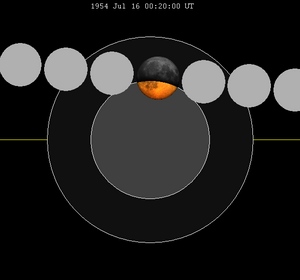| Partial eclipse | |||||||||||||
 The Moon's hourly motion shown right to left The Moon's hourly motion shown right to left | |||||||||||||
| Date | July 16, 1954 | ||||||||||||
|---|---|---|---|---|---|---|---|---|---|---|---|---|---|
| Gamma | 0.7877 | ||||||||||||
| Magnitude | 0.4054 | ||||||||||||
| Saros cycle | 138 (26 of 83) | ||||||||||||
| Partiality | 140 minutes, 55 seconds | ||||||||||||
| Penumbral | 301 minutes, 37 seconds | ||||||||||||
| |||||||||||||
| ← January 1954January 1955 → | |||||||||||||
A partial lunar eclipse occurred at the Moon’s ascending node of orbit on Friday, July 16, 1954, with an umbral magnitude of 0.4054. A lunar eclipse occurs when the Moon moves into the Earth's shadow, causing the Moon to be darkened. A partial lunar eclipse occurs when one part of the Moon is in the Earth's umbra, while the other part is in the Earth's penumbra. Unlike a solar eclipse, which can only be viewed from a relatively small area of the world, a lunar eclipse may be viewed from anywhere on the night side of Earth. The Moon's apparent diameter was near the average diameter because it occurred 6.6 days after apogee (on July 9, 1954, at 9:25 UTC) and 7.8 days before perigee (on July 23, 1954, at 19:30 UTC).
Visibility
The eclipse was completely visible over eastern South America, Africa, Europe, and Antarctica, seen rising over northwestern South America and much of central and eastern North America and setting over eastern Europe, the western half of Asia, and western Australia.
 
|
Eclipse details
Shown below is a table displaying details about this particular solar eclipse. It describes various parameters pertaining to this eclipse.
| Parameter | Value |
|---|---|
| Penumbral Magnitude | 1.42024 |
| Umbral Magnitude | 0.40537 |
| Gamma | 0.78767 |
| Sun Right Ascension | 07h39m05.3s |
| Sun Declination | +21°29'36.6" |
| Sun Semi-Diameter | 15'44.2" |
| Sun Equatorial Horizontal Parallax | 08.7" |
| Moon Right Ascension | 19h38m14.9s |
| Moon Declination | -20°46'21.3" |
| Moon Semi-Diameter | 15'30.4" |
| Moon Equatorial Horizontal Parallax | 0°56'54.4" |
| ΔT | 30.9 s |
Eclipse season
See also: Eclipse cycleThis eclipse is part of an eclipse season, a period, roughly every six months, when eclipses occur. Only two (or occasionally three) eclipse seasons occur each year, and each season lasts about 35 days and repeats just short of six months (173 days) later; thus two full eclipse seasons always occur each year. Either two or three eclipses happen each eclipse season. In the sequence below, each eclipse is separated by a fortnight.
| June 30 Descending node (new moon) |
July 16 Ascending node (full moon) |
|---|---|
 |

|
| Total solar eclipse Solar Saros 126 |
Partial lunar eclipse Lunar Saros 138 |
Related eclipses
Eclipses in 1954
- An annular solar eclipse on January 5.
- A total lunar eclipse on January 19.
- A total solar eclipse on June 30.
- A partial lunar eclipse on July 16.
- An annular solar eclipse on December 25.
Metonic
- Preceded by: Lunar eclipse of September 26, 1950
- Followed by: Lunar eclipse of May 3, 1958
Tzolkinex
- Preceded by: Lunar eclipse of June 3, 1947
- Followed by: Lunar eclipse of August 26, 1961
Half-Saros
- Preceded by: Solar eclipse of July 9, 1945
- Followed by: Solar eclipse of July 20, 1963
Tritos
- Preceded by: Lunar eclipse of August 15, 1943
- Followed by: Lunar eclipse of June 14, 1965
Lunar Saros 138
- Preceded by: Lunar eclipse of July 4, 1936
- Followed by: Lunar eclipse of July 26, 1972
Inex
- Preceded by: Lunar eclipse of August 4, 1925
- Followed by: Lunar eclipse of June 25, 1983
Triad
- Preceded by: Lunar eclipse of September 14, 1867
- Followed by: Lunar eclipse of May 16, 2041
Lunar eclipses of 1951–1955
| Descending node | Ascending node | |||||
|---|---|---|---|---|---|---|
| Saros | Date viewing |
Type chart |
Saros | Date viewing |
Type chart | |
| 103 | 1951 Feb 21
|
Penumbral
|
108 | 1951 Aug 17
|
Penumbral
| |
| 113 | 1952 Feb 11
|
Partial
|
118 | 1952 Aug 5
|
Partial
| |
| 123 | 1953 Jan 29
|
Total
|
128 | 1953 Jul 26
|
Total
| |
| 133 | 1954 Jan 19
|
Total
|
138 | 1954 Jul 16
|
Partial
| |
| 143 | 1955 Jan 8
|
Penumbral
| ||||
| Last set | 1951 Mar 23 | Last set | 1951 Sep 15 | |||
| Next set | 1955 Nov 29 | Next set | 1955 Jun 5 | |||
Saros 138
It was part of Saros series 138.
Half-Saros cycle
A lunar eclipse will be preceded and followed by solar eclipses by 9 years and 5.5 days (a half saros). This lunar eclipse is related to two total solar eclipses of Solar Saros 145.
| July 9, 1945 | July 20, 1963 |
|---|---|

|

|
See also
Notes
- "July 15–16, 1954 Partial Lunar Eclipse". timeanddate. Retrieved 22 December 2024.
- "Moon Distances for London, United Kingdom, England". timeanddate. Retrieved 22 December 2024.
- "Partial Lunar Eclipse of 1954 Jul 16" (PDF). NASA. Retrieved 22 December 2024.
- "Partial Lunar Eclipse of 1954 Jul 16". EclipseWise.com. Retrieved 22 December 2024.
- Mathematical Astronomy Morsels, Jean Meeus, p.110, Chapter 18, The half-saros
External links
- 1954 Jul 16 chart Eclipse Predictions by Fred Espenak, NASA/GSFC
This lunar eclipse-related article is a stub. You can help Misplaced Pages by expanding it. |


